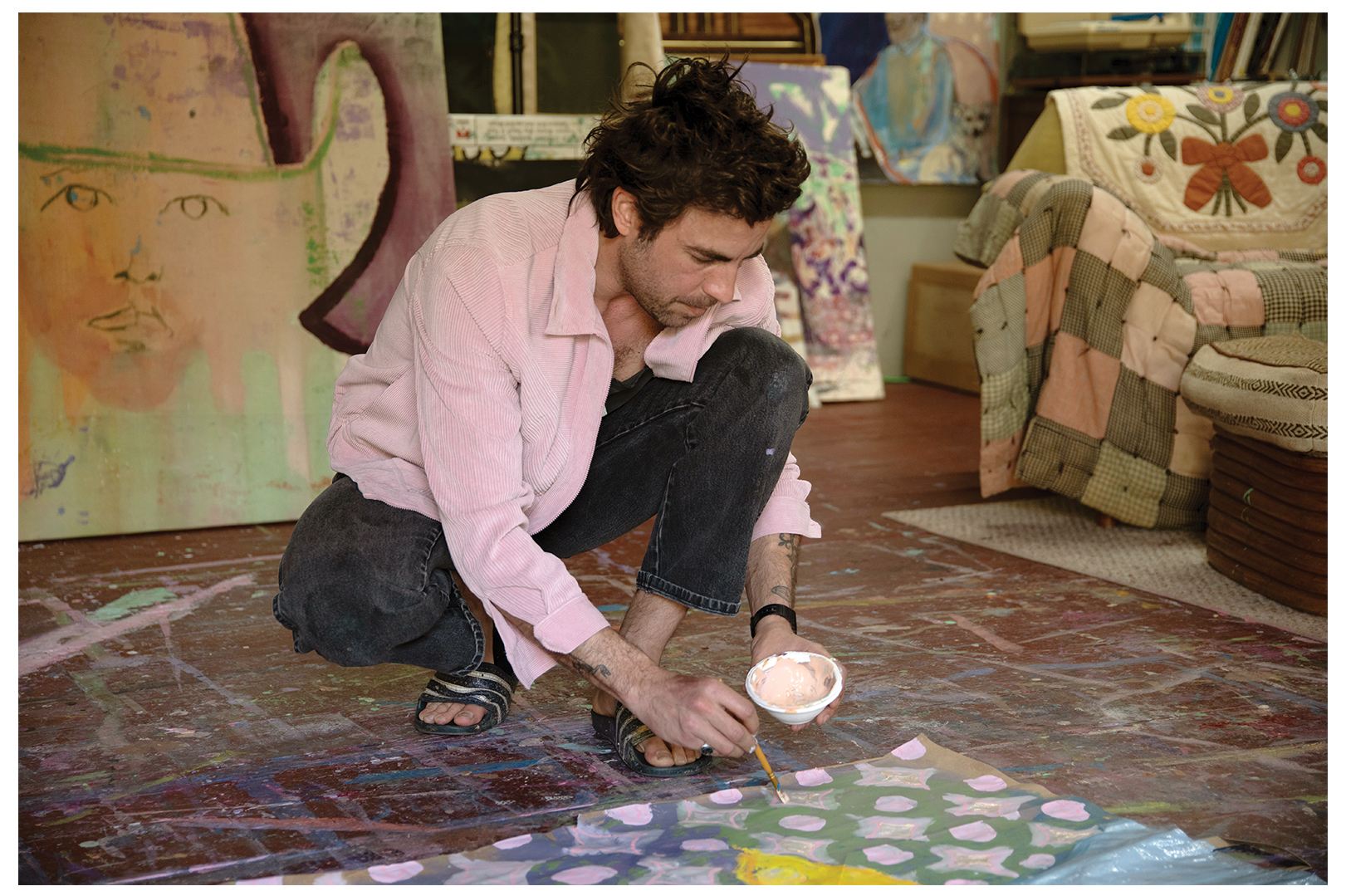Plus, he takes readers on a video tour of his studio

Before the pandemic, you could find musician Nathan Edwin McClements playing a show somewhere around town with his band, Deadwin, nearly every other day. When gigs dried up during COVID restrictions, McClements turned his attention back to his roots in visual art. He rented a beautiful old building in North Charleston to use as an art and recording studio, as well as a storefront for his vintage clothing collection, and started creating.
After two years of making work for himself, he’s sharing his creativity, often using found materials, such as grocery bags, burlap, old denim, vinyl record sleeves, and cardboard, as his canvas or incorporating them into his mixed-use paintings of skulls, cowboys, musicians, and other colorful figures. In February, his cowboys appeared on limited-edition packages of Red Clay Hot Sauce. Here, McClements discusses how he has gone from “aimless” to having “ever-growing” creative energy.

Artist Nathan Edwin McClements paints cowboys, musicians, and other colorful figures on found objects, such as (left) Gold Head (acrylic and oil pastel on color test paper from a large format printer, 48 x 65 inches, 2023) and (right) Cowboy with Lilly (acrylic and oil pastel on double grocery bag, 38 x 38 inches, 2024).
Artistic Roots: I always wanted to create, and I had no options outside of going the college route. I went to Ball State University and Bethel University in Indiana, but I was an awful student in general, and I just got more insecure as an artist. I had a lot of creative freedom, but it wasn’t pulling anything out of me that inspired more. It took me a long time to finish school. After I graduated, I focused more on writing tunes and started touring as a musician.
In Transition: I play guitar and harmonica, but my first instrument was a trumpet, so when I started recording, I would grab whatever instrument was around. It’s similar to how I paint; building up layers to present more of a story. I ended up in Nashville working on a record and was hoping to play more, but I didn’t have much confidence in my work so I was just surviving. About 10 years ago, I visited a friend on Folly Beach and saw the potential of playing here far exceeded Nashville. I could play as many gigs as I wanted and make a humble living. I moved here, met my drummer, and we played a lot. Once, we played 150 gigs in a year. It was really draining; it’s a tough life.
Back to Art: I had accumulated a bunch of art materials, and I started using whatever was around me—just exploring color and what it feels like to create visually. The pandemic was a good time for me to step back from a kind of a toxic existence and dig into this other thing. It was the best pivot for me.
Showing Up: I spent the first two years creating for creation’s sake without much interest in others seeing the work. Eventually, I needed to share it and to see how the response felt. As a musician, sharing is such a big part of the experience, and the participation from others feels necessary. I was inspired by the encouragement and surprised it took off the way it did.
Finding His Scene: DIY shows outside of galleries started popping up after the pandemic, and I found other people who also started creating during the downtime. They’d gone through similar pivots and became part of my family. It was a neat scene, and it was good for me to show work outside of the gallery circuit that had made me feel insecure as a creator.

Vintage Finds: I’ve been collecting vintage clothes for a long time, and Nashville had a big influence on that. I’m always at thrift stores; it’s something I’ve done since middle school. So, my buddies and I started popping up wherever we could find a space or a parking lot. It’s not my goal to make a living from it, but it lets me keep shopping and curating things that someone else can find as their favorite. There’s a life and a story still to be told with these things.
Intersecting Creative Paths: With vintage, art, and music, I realized I can do these things anywhere, and it doesn’t have to be a big set up where the wrong people are curating. It feels so freeing to not have someone dictating the price or style, and my price point isn’t affected by other people taking such a high cut. There’s a ton of potential for more of that model to work here; we have a lot of beautiful spaces and a lot of empty spaces. The city is overlooking the potential of what creatives can do, even temporarily, in those places as a means to encourage substantial cultural growth.
Looking Ahead: I’m getting my studio ready so it can be a storefront for artwork and vintage. I’m writing and recording an album, while pushing for my studio to become a more communal space. I’ll keep doing pop-ups, and you can always find my work at A Maker’s Post on Sullivan’s Island.
LISTEN UP: Watch a music video for "Sway Me" by Nathan Edwin McClements:
Video shot by Willie C. Simmos